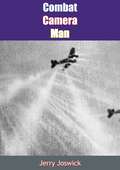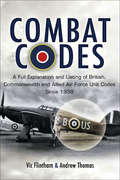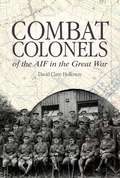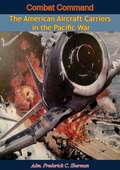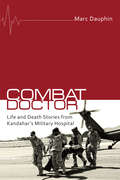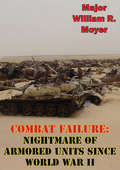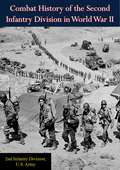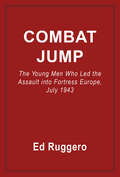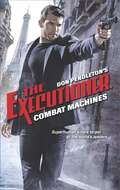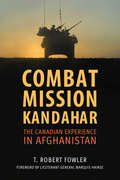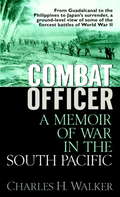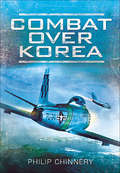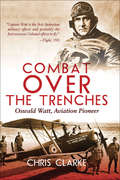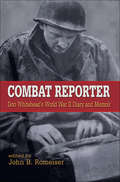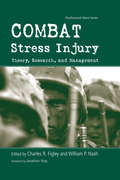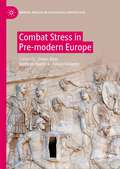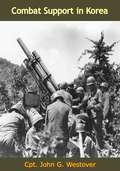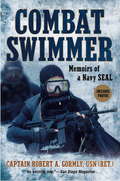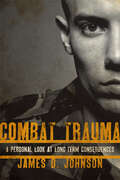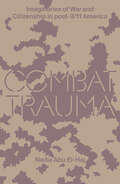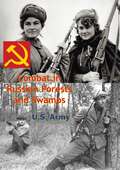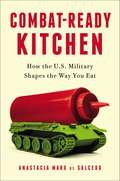- Table View
- List View
Combat Cameraman
by Sgt. Jerry J. JoswickOVER THE TARGET…The movie camera in my hands was ready as we entered our run over the oil fields of Ploesti. Cracking towers, smokestacks, huge oil storage tanks and outbuildings almost scraped the Witch’s belly as we let go the incendiaries.Through the camera’s lens I saw a B-24 fly into a barrage balloon cable. The plane spun, corkscrewed to the ground and exploded. Beyond, I saw another smash into a smokestack and instantly dissolve into a fireball.The heat from the storage tank fires turned the Witch into an oven, searing my hair and eyebrows. I swung the camera to see planes crisscrossing, exploding in air, being swallowed up in the raging fires and curling black smoke.Ahead, four hundred deadly German fighters hovered high overhead—waiting for revenge.…This is the thrilling story of Sergeant Jerry Joswick, COMBAT CAMERAMANDodging bullets and bombs, he “shot” his way through some of the most savage fighting in World War II, taking memorable pictures of the terrible face of war——in Africa, on a commando raid behind Rommel’s lines—on the disastrous Ploesti air raid, which he was the only cameraman of sixteen to survive—in the first wave of D-Day on Omaha Beach—in the Battle of the Bulge, where he traded camera for rifle to stay alive—parachuting into Germany with the AirborneThrills, action, the shock of battle—and the determinate to get the picture, no matter what the danger—make COMBAT CAMERAMAN one of the most thrilling books to come out of the Second World War.
Combat Codes: A Full Explanation and Listing of British, Commonwealth and Allied Air Force Unit Codes Since 1938
by Andrew Thomas Vic FlinthamThe authors of 'Combat Codes' have painstakingly researched the codes used by the RAF to replace unit markings during World War II in order to attempt to confuse the enemy.
Combat Colonels: of the AIF in the Great War
by David Clare HollowayCombat Colonels seeks to address the regrettable gap in Australia's documented history of its combat colonels. Its purpose is to name all the Commanding Officers who led units into actions in the Great War and to describe their lives before and, for those who survived, after the war. From these pages emerge the men who shaped Australia's battlefield history - both the professional soldiers and the former teachers, accountants, salesmen, clerks, farmers and others from a broad range of occupations whose leadership on and off the battlefield proved so crucial. These are men Australia cannot afford to forget.
Combat Command: The American Aircraft Carriers in the Pacific War
by Adm. Frederick C. ShermanCOMMANDING THE LEXINGTON DURING THE BATTLE OF THE CORAL SEAI saw the enemy torpedo planes coming in on both bows. The air was full of antiaircraft bursts and the din was terrific. I motioned to the helmsman for a hard left rudder, just as the enemy planes started disgorging their fish.The water in all directions seemed full of torpedo wakes. Bombs were dropping all around us. Great geysers of water from near misses were going up higher than our masts, and the ship shuddered from the explosions of the ones that hit.The enemy planes split up to fire on both bows, the hardest maneuver for us to counter. Then I remember seeing two wakes coming straight for our port beam, and there was nothing I could do about them. The wakes approached the ship’s side, and I braced myself for the explosion....COMBAT COMMAND
Combat Doctor: Life and Death Stories from Kandahar's Military Hospital
by Marc DauphinAn emergency room doctor recounts harrowing stories about his time at a combat hospital in Kandahar. Combat Doctor presents the stories of the victims of the War in Afghanistan, as told by the last Canadian Officer Commanding at the Kandahar Role 3 Multinational Hospital. In 2009, Marc Dauphin, an experienced emergency-room physician, served a full tour at the combat hospital in Kandahar. During his time there, he dealt with injuries more horrific than he had ever seen during his civilian experience. He and the Role 3 Hospital’s international staff saw an unparalleled number of severe casualties and yet maintained a survival rate of 97 percent – a record for all times and all wars. It is impossible to remain unmoved by Marc Dauphin’s descriptions of those he treated: the terrified children, the stoic soldiers, those mutilated almost beyond help. Each story is powerful, vividly told, and unique.
Combat Failure: Nightmare of Armored Units Since World War II
by Major William R. MoyerThis monograph examines the relationship between physical forces prevalent on the modern battlefield and the causes inherent to US armored battalion failure since World War II. Given the complexity of today's battlefield in terms of technology, command and control, and lethality, examining the physical aspects of failure can offer the clearest understanding of unit failure as a whole; after all, physical actions and reactions in battle are more easily analyzed.To determine the relationship between armored failure and physical forces on the battlefield, I first provide some theoretical and contemporary perspectives on the physical aspects of unit failure. Next, the causes and conditions of battlefield failure are identified and examined, followed by a discussion of the processes of failure. After laying a foundation of theory and the processes of failure, historical examples as well as recent armored NTC experiences are examined to determine the decisive causes of failure for US armor units since World War II.My conclusion is that effective enemy maneuver, when complimented with overwhelming fires is the decisive cause of failure for US armored units since World War II. Maneuver sets the conditions for both physical and moral destruction. However, failure is difficult to isolate; it is complex and occurs most often because of a combination of actions rarely just one. Clearly, technology has a great deal to do with physical failure. Maneuver, firepower, and protection have increased the power and importance of physical forces in relation to moral and cybernetic forces. Ultimately, overwhelming enemy maneuver and fires rapidly destroy unit cohesion as well as the physical capabilities of the defeated unit.
Combat History of the Second Infantry Division in World War II
by U. S. ArmyFirst published just a year after the end of the war, this is the story of the Second Infantry Division in World War II. It is the story of innumerable acts of fortitude and courage, of individual sacrifice and devotion to duty under fire, by a fighting division which has served with honor in two world wars.“Closely following actual combat operations, brief editions of our participation in World War II were published. With the passage of time, the need for a more authentic and comprehensive history of this period has become evident. This book is designed to meet that need.“This history shows that from D+1 to V-E Day our Division, in the face of repeated fanatical enemy action, was employed constantly as a spearhead shock division, and that in this role it maintained unblemished its proud record of never having failed to take its objective nor of having relinquished ground so gained. During operations we were concerned with our immediate task. Now in the light of subsequent events and broader perspective, the importance to the nation and to our army of our successes becomes increasingly evident.”—W. M. Robertson, Major-General, U.S. Army
Combat Jump
by Ed RuggeroThe hair-raising, frontline account of the first American airborne invasion of World War II and of the young paratroopers who risked their lives for freedom. By 1943, the war in Europe had reached a turning point. General Dwight Eisenhower was given orders to invade Sicily and head north. To achieve this, Ike had a new weapon: U.S. paratroopers. Their mission was to seize the approaches to the invasion beaches and to hold off German attacks.Combat Jump tells the little-known story of these paratroopers and how they changed the American way of war. It takes readers on their journey from civilians to citizen soldiers, through training in the United States and later in North Africa, and then shows their daring jump into the darkness over enemy-held Sicily.By first light on D-day, July 10, 1943, it looked as if the mission would fail. Inexperienced pilots, lost or blown off course, dropped 80 percent of the troopers from one to sixty-five miles from their targets. The American commander, James Gavin, landed so far from his objective that he was not even sure he was in Sicily. Arthur Gorham, commanding 500 men of the First Battalion, encountered two surprises when the sun came up. He and just over 100 of his men were the only GIs -- out of 3,400 dropped -- near their objective. He also discovered that the Germans in Sicily had tanks. The lightly armed paratroopers, with their rifles and hand grenades, were not equipped to take on the forty-ton panzers. But against all odds, they did. The costly lessons they learned shaped the war in Europe, for without Sicily, there might have been no airborne invasion of France in June 1944.Combat Jump recounts the extraordinary contributions these young men made when their country called them to war, and it tells a classic tale of military action and remarkable courage.Well-written and flowing like a good novel, this book is highly recommended.--Library JournalA winner...Ruggero's thorough resarch, including interviewswith many survivors, and excellent writing earns this book a permanent place in any WWII collection.--Booklist
Combat Machines
by Don PendletonKILLER OFFENSIVE One by one, European leaders are dying by assassination. And each of the victims opposed Russia's attempts to gain increasing power. Determined to stop this wave of terror before it hits American shores, Mack Bolan uses the killers' next attack to flush them out. But these assassins are inhumanly fast, impervious to pain and programmed with cutting-edge combat skills by a hard-line Soviet scientist. Now Bolan is being shadowed by a ruthless Russian intelligence team racing to bury him along with this rogue military project. To save a summit of world leaders, the Executioner must play two brutal factions against each other...and send the assassins' creator to meet his maker.
Combat Mission Kandahar: The Canadian Experience in Afghanistan
by T. Robert FowlerSeven soldiers. Seven military specialties. Seven stories. What was it like to serve in the combat mission in Afghanistan? Journalists’ reports from 2006 to 2011 could only give brief glimpses of the reality on the ground for Canadian soldiers. This book reveals the full story of what happened to seven soldiers, ranking from corporal to captain, who were deployed during Operation ATHENA, Phase 2. The operation became known as “the combat mission” as Canadian battle groups engaged in a deadly multi-year war of counter-insurgency in Kandahar province. Each of the seven soldier’s experiences covered in Combat Mission Kandahar highlights a facet of one of Canada’s longest, most complicated, and challenging operations.
Combat Nurses of World War II
by Wyatt BlassingameDuring the second World War, the army and Navy needed help to care for the many injured troops. So, they turned to nurses. And these are some of the nurses' stories.
Combat Officer
by Charles H. WalkerOn the eve of battle, 2nd Lt. Walker was ordered back to the States for medical reasons. But there was a war to be won, and he had no intention of missing it. In this devastatingly powerful memoir, Walker captures the conflict in all its horror, chaos, and heroism: the hunger, the heat, the deafening explosions and stench of death, the constant fear broken by moments of sheer terror. This is the gripping tale of the brave young American men who fought with tremendous courage in appalling conditions, willing to sacrifice everything for their country.
Combat Over Korea
by Philip ChinneryCombat Over Korea offers a superb selection of thrilling accounts by Allied airmen of their experiences. These include air combat between fighters, a B29 Superfortress bomber ditching in the sea, C-54 cargo plane being attacked by North Korean fighters. We read of the exploits of the 21 Troop Carrier Squadron (The Kyushu Gipsies) who flew into impossibly short strips to rescue thousands of wounded soldiers they received the Presidential Citation for their feat. Others tell of their hair-raising escapades after being shot down. While a number miraculously avoided capture (often due to the skill of fellow pilots), many were less lucky. Their treatment in captivity was often brutal. Very few escaped but 1st Lieutenant Melvin Shadduck did and he tells his story here, as do others who have remarkable experiences to describe. While it was not until 1955 that the last POWs were released, the Author concludes that there is every possibility that a number were denied freedom forever.
Combat Over the Trenches: Oswald Watt, Aviation Pioneer
by Chris Clarke'Father of the Flying Corps' and 'Father of Australian Aviation' were two of the unofficial titles conferred on Oswald ("Toby") Watt when he died in tragic circumstances shortly after the end of the First World War. He had become the Australian Army's first qualified pilot in 1911, but spent the first 18 months of the war with the French Air Service, the Aronautique Militaire, before arranging a transfer to the Australian Imperial Force. Already an experienced combat pilot, he rose quickly through the ranks of the Australian Flying Corps, becoming a squadron leader and leading his unit at the battle of Cambrai, then commander of No 1 Training Wing with the senior AFC rank of lieutenant colonel.These were elements in a colorful and at times a romantic career long existing interest and attention - not just during Watt's lifetime but in the interval since his death nearly a century ago. His name had been rarely out of Australian newspapers for more than a decade before the war, reflecting his wealthy lifestyle and extensive and influential social and political connections. But this focus has enveloped Watt's story with an array of false and misleading elements verging on mythology. For the first time, this book attempts to establish the true story of Watt's life and achievements, and provide a proper basis for evaluating his place in Australian history.
Combat Reporter: Don Whitehead's World War II Diary and Memoirs (World War II: The Global, Human, and Ethical Dimension)
by Don Whitehead“No one bore witness better than Don Whitehead . . . this volume, deftly combining his diary and a previously unpublished memoir, brings Whitehead and his reporting back to life, and 21st-century readers are the richer for it.”—from the Foreword, by Rick AtkinsonWinner of two Pulitzer Prizes, Don Whitehead is one of the legendary reporters of World War II. For the Associated Press he covered almost every important Allied invasion and campaign in Europe—from North Africa to landings in Sicily, Salerno, Anzio, and Normandy, and to the drive into Germany. His dispatches, published in the recent Beachhead Don, are treasures of wartime journalism.From the fall of September 1942, as a freshly minted A.P. journalist in New York, to the spring of 1943 as Allied tanks closed in on the Germans in Tunisia, Whitehead kept a diary of his experiences as a rookie combat reporter. The diary stops in 1943, and it has remained unpublished until now. Back home later, Whitehead started, but never finished, a memoir of his extraordinary life in combat.John Romeiser has woven both the North African diary and Whitehead’s memoir of the subsequent landings in Sicily into a vivid, unvarnished, and completely riveting story of eight months during some of the most brutal combat of the war. Here, Whitehead captures the fierce fighting in the African desert and Sicilian mountains, as well as rare insights into the daily grind of reporting from a war zone, where tedium alternated with terror. In the tradition of cartoonist Bill Mauldin’s memoir Up Front, Don Whitehead’s powerful self-portrait is destined to become an American classic.
Combat Stress Injury: Theory, Research, and Management (Psychosocial Stress Series)
by William P. Nash Charles R. FigleyCombat Stress Injury represents a definitive collection of the most current theory, research, and practice in the area of combat and operational stress management, edited by two experts in the field. In this book, Charles Figley and Bill Nash have assembled a wide-ranging group of authors (military / nonmilitary, American / international, combat veterans / trainers, and as diverse as psychiatrists / psychologists / social workers / nurses / clergy / physiologists / military scientists). The chapters in this volume collectively demonstrate that combat stress can effectively be managed through prevention and training prior to combat, stress reduction methods during operations, and desensitization programs immediately following combat exposure.
Combat Stress in Pre-modern Europe (Mental Health in Historical Perspective)
by Jason Crowley Kathryn Hurlock Owen ReesThis book examines the lasting impact of war on individuals and their communities in pre-modern Europe. Research on combat stress in the modern era regularly draws upon the past for inspiration and validation, but to date no single volume has effectively scrutinised the universal nature of combat stress and its associated modern diagnoses. Highlighting the methodological obstacles of using modern medical and psychological models to understand pre-modern experiences, this book challenges existing studies and presents innovative new directions for future research. With cutting-edge contributions from experts in history, classics and medical humanities, the collection has a broad chronological focus, covering periods from Archaic Greece (c. sixth and early fifth century BCE) to the British Civil Wars (seventeenth century CE). Topics range from the methodological, such as the dangers of retrospective diagnosis and the applicability of Moral Injury to the past, to the conventionally historical, examining how combat stress and post-traumatic stress disorder may or may not have manifested in different time periods. With chapters focusing on combatants, women, children and the collective trauma of their communities, this collection will be of great interest to those researching the history of mental health in the pre-modern period.
Combat Support in Korea
by Cpt. John G. WestoverOne of the cherished beliefs of those who do not know is that the logistical services of the Army lead a safe and boring life, even in the combat zone.The Combat Engineers and the Signal Corps began to cloud this belief in World War I. The Medical Corps, the Chemical Corps and the Bomb Disposal squads of the Ordnance Corps began to demand respect as dangerous assignments in World War II. In Korea all the services won the right to be shot at.War becomes increasingly a matter of logistics. The thin cutting edge of infantry, armor and artillery still contains the larger proportion of heroes, dead and alive, but these combat arms depend more and more on the services to provide them not only with the traditional beans and bullets, but with gasoline, transportation, medical service, concealing smoke, communications equipment, graves registration, potable water, laundry service—the list is endless.Here are some true accounts that tell how the services fulfilled their missions in a tough and dirty little war. There are tales of devotion to duty that match those of any combat arm. There are roles of technical proficiency combined with the foresight to seize opportunities as they arose. But because these are true stories, there are descriptions of actions whose only value is to indicate what should not be done, what lock of preparedness means in lives and dollars.Here is an honest book—one that had to be honest because it was conceived to tell the whole truth, for the education of our army. This is a book for every soldier, every youth who might become a soldier, every parent of every such youth.He succeeded, and the fruit of his labors is here.
Combat Swimmer
by Robert A. GormlyFor the first time in trade paperback-a classic memoir of Navy SEALs in action. In gripping prose, Captain Robert A. Gormly tells about his days as a leader in the Navy SEALs- taking readers into the night, into the water, and into battle on some of the most hair-raising missions ever assigned. Trained to a fine fighting edge just in time for Vietnam, Gormly served two tours of duty and engaged in top-secret missions in the Persian Gulf. Here, he shares his viewpoint and his experience-including what is perhaps the most graphic description ever of SEAL action in the invasion of Grenada. Gormly takes readers behind the myth of this awesome team, revealing how their lives depend on their unprecedented expertise and unparalleled courage. .
Combat Trauma: A Personal Look at Long-Term Consequences
by James D Johnson&“In this incredibly courageous expose,&” Vietnam veterans discuss the long-lasting effects of PTSD and their strategies for coping (Publishers Weekly). Though much has been written about the short-term experience of combat trauma, very few resources discuss how that trauma continues to impact individuals into later life. In this volume, retired Army Chaplain James D. Johnson relates how fifteen Vietnam veterans have been affected by the terror they experienced four decades ago, and how it continues to affect them today. With candor and vivid detail, they reveal how their combat trauma symptoms still infect their thoughts, feelings, and behaviors on a daily basis. Their stories offer valuable insight for today&’s soldiers returning from battle, as well as for their loved ones. The experiences shared here can help them address and cope with the ongoing challenges of PTSD. Those who still carry these wounds will find that they are not alone, and that there are ways of dealing with the horror, no matter how long ago it took place.
Combat Trauma: Imaginaries of War and Citizenship in post-9/11 America
by Nadia Abu El-HajAmericans have long been asked to support the troops and care for veterans&’ psychological wounds. Who, though, does this injunction serve? As acclaimed scholar Nadia Abu El-Haj argues here, in the American public&’s imagination, the traumatized soldier stands in for destructive wars abroad, with decisive ramifications in the post-9/11 era. Across the political spectrum the language of soldier trauma is used to discuss American warfare, producing a narrative in which traumatized soldiers are the only acknowledged casualties of war, while those killed by American firepower are largely sidelined and forgotten. In this wide-ranging and fascinating study of the meshing of medicine, science, and politics, Abu El-Haj explores the concept of post-traumatic stress disorder and the history of its medical diagnosis. While antiwar Vietnam War veterans sought to address their psychological pain even as they maintained full awareness of their guilt and responsibility for perpetrating atrocities on the killing fields of Vietnam, by the 1980s, a peculiar convergence of feminist activism against sexual violence and Reagan&’s right-wing &“war on crime&” transformed the idea of PTSD into a condition of victimhood. In so doing, the meaning of Vietnam veterans&’ trauma would also shift, moving away from a political space of reckoning with guilt and complicity to one that cast them as blameless victims of a hostile public upon their return home. This is how, in the post-9/11 era of the Wars on Terror, the injunction to &“support our troops,&” came to both sustain US militarism and also shields American civilians from the reality of wars fought ostensibly in their name. In this compelling and crucial account, Nadia Abu El-Haj challenges us to think anew about the devastations of the post-9/11 era.
Combat and Genocide on the Eastern Front
by Jeff RutherfordBy 1944, the overwhelming majority of the German Army had participated in the German war of annihilation in the Soviet Union and historians continue to debate the motivations behind the violence unleashed in the east. Jeff Rutherford offers an important new contribution to this debate through a study of combat and the occupation policies of three frontline infantry divisions. He shows that while Nazi racial ideology provided a legitimizing context in which violence was not only accepted but encouraged, it was the Wehrmacht's adherence to a doctrine of military necessity which is critical in explaining why German soldiers fought as they did. This meant that the German Army would do whatever was necessary to emerge victorious on the battlefield. Periods of brutality were intermixed with conciliation as the army's view and treatment of the civilian population evolved based on its appreciation of the larger context of war in the east.
Combat in Russian Forests and Swamps
by U. S. ArmyCombat in Russian Forests and Swamps, prepared for the Historical Division, EUCOM, by a committee of former German generals and general staff officers, deals with the principles of combat in the vast woodlands and swamps of European Russia. The main author and all other contributors have drawn upon their own extensive experience on the Eastern Front and that of their allies, especially the Finns, to present the actual lessons learned from the events of the war. When the study was translated and prepared for publication, every effort was made to retain the point of view, the expressions, and even the prejudices of the original authors.The reader is reminded that publications in the GERMAN Report SERIES were written by Germans from the German point of view. Throughout this study, any mention of “normal methods” or standard infantry tactics refers to German combat doctrines, and applies to units organized and equipped in accordance with German regulations. Similarly, the recommendations contained in the final section are made against the background of German methods of individual and unit training before and during World War II.
Combat! The Counterattack
by Franklin M. DavisA novel based on the American Broadcasting Company Television Series
Combat-Ready Kitchen
by Anastacia Marx de SalcedoAmericans eat more processed foods than anyone else in the world. We also spend more on military research. These two seemingly unrelated facts are inextricably linked. If you ever wondered how ready-to-eat foods infiltrated your kitchen, you'll love this entertaining romp through the secret military history of practically everything you buy at the supermarket.In a nondescript Boston suburb, in a handful of low buildings buffered by trees and a lake, a group of men and women spend their days researching, testing, tasting, and producing the foods that form the bedrock of the American diet. If you stumbled into the facility, you might think the technicians dressed in lab coats and the shiny kitchen equipment belonged to one of the giant food conglomerates responsible for your favorite brand of frozen pizza or microwavable breakfast burritos. So you'd be surprised to learn that you've just entered the U.S. Army Natick Soldier Systems Center, ground zero for the processed food industry.Ever since Napoleon, armies have sought better ways to preserve, store, and transport food for battle. As part of this quest, although most people don't realize it, the U.S. military spearheaded the invention of energy bars, restructured meat, extended-life bread, instant coffee, and much more. But there's been an insidious mission creep: because the military enlisted industry--huge corporations such as ADM, ConAgra, General Mills, Hershey, Hormel, Mars, Nabisco, Reynolds, Smithfield, Swift, Tyson, and Unilever--to help develop and manufacture food for soldiers on the front line, over the years combat rations, or the key technologies used in engineering them, have ended up dominating grocery store shelves and refrigerator cases. TV dinners, the cheese powder in snack foods, cling wrap . . . The list is almost endless.Now food writer Anastacia Marx de Salcedo scrutinizes the world of processed food and its long relationship with the military--unveiling the twists, turns, successes, failures, and products that have found their way from the armed forces' and contractors' laboratories into our kitchens. In developing these rations, the army was looking for some of the very same qualities as we do in our hectic, fast-paced twenty-first-century lives: portability, ease of preparation, extended shelf life at room temperature, affordability, and appeal to even the least adventurous eaters. In other words, the military has us chowing down like special ops.What is the effect of such a diet, eaten--as it is by soldiers and most consumers--day in and day out, year after year? We don't really know. We're the guinea pigs in a giant public health experiment, one in which science and technology, at the beck and call of the military, have taken over our kitchens.From the Hardcover edition.
